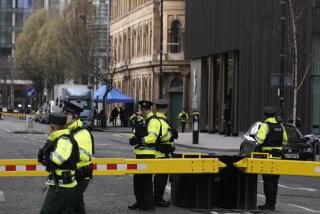Irish Nationalist Takes Case to Capitol Hill : Ulster: Sinn Fein leader is told Clinton has lifted a ban on official contacts with his group, the political arm of the IRA.
- Share via
WASHINGTON — After a quarter-century as a political untouchable, the leader of the political arm of the Irish Republican Army entered the mainstream Monday, complete with all trappings: a news conference on the steps of the U.S. Capitol, meals with senators and representatives and even an appearance on a national talk show.
Gerry Adams, the adroit president of the IRA political group, Sinn Fein, awoke to a phone call from Vice President Al Gore telling him that President Clinton had decided to lift the ban on official contacts with his group and inviting him to a meeting today with mid-level State Department officials.
“Not bad for a fella who was a terrorist a month ago,” said one of the Irish journalists who is following Adams on his two-week tour of the United States, whispering audibly on hearing the announcement of the phone call from Gore.
The gesture from the Clinton Administration offered access at a lower level than Adams may have wanted but was nonetheless symbolic of a very long journey in a very brief time. Just a few weeks ago, Adams’ image and voice were still banned on British radio and television. Until Sunday, he was not allowed to have official contact with the U.S. government. Until February, he was officially considered an international killer prohibited from entering this country.
The change in U.S. policy was prompted by the IRA’s announcement Aug. 31 of a cease-fire in its 25-year fight against British rule in Northern Ireland.
As he began his tour of Washington, starting with a congressional breakfast with Sen. Alfonse M. D’Amato (R-N.Y.) and Rep. Peter T. King (R-N.Y.), the tall, bearded Adams seemed to have command of many nuances of American politics. He even dressed in the uniform that politicians have deemed best for TV appeal--dark blue suit, blue shirt and red tie.
“Do you consider yourself in American political terms more a Democrat or a Republican?” one reporter shouted as Adams headed into the Capitol for a luncheon.
“An Irish Republican,” the 48-year-old former prisoner and victim of bombing attacks on his home quickly shot back.
“How does it feel to be headed into the Capitol?” another asked.
“A lot of what is everyday life here is absent in my country,” he answered. “The right to assembly, freedom of speech, the right to jury trial. You should cherish this. It’s almost like culture shock to me.”
Later he met with Senate Minority Leader Bob Dole (R-Kan.) and House Speaker Thomas S. Foley (D-Wash.) and then sat between two rival groups of lawmakers who had taken opposite sides on the Irish conflict.
Throughout the day, Adams struck a carefully conciliatory tone, using his gift of gab to try to persuade doubters who consider him a terrorist.
“The unionists have as much right to be on the island of Ireland as I do,” he said at one point of the Protestants he has been fighting for 25 years.
The fighting in Northern Ireland has not yet ended, he said, but he blamed the British for that and suggested that the IRA is living up to its cease-fire promise.
Unknown to most Americans until only a few months ago, Adams was officially viewed as the de facto general of the IRA’s bombing war against military and civilian targets.
But Adams emerged as the only figure with enough stature and credibility to persuade more-militant factions of the IRA to accept the offer from London and Dublin late last year for peace talks.
Today, Adams will have his meeting at the State Department--not the White House, as he reportedly had hoped--with John Kornblum, assistant secretary of state for European affairs; Leon Furth, the vice president’s national security adviser, and Nancy Soderberg, an official of the President’s National Security Council.
After that, Adams’ visit, which began in Boston and New York, will include Hartford, Conn.; Detroit; Cleveland; Philadelphia; San Francisco and Los Angeles.
More to Read
Sign up for Essential California
The most important California stories and recommendations in your inbox every morning.
You may occasionally receive promotional content from the Los Angeles Times.












